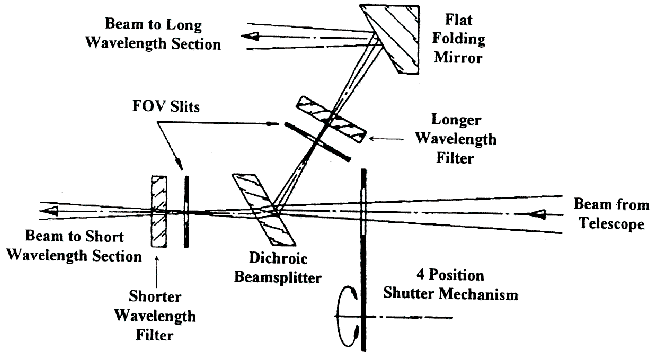
4.) Dichroics

Figure: The SWS input section
Table: SWS channel pairings
| Aperture |
Beamsplitter |
SW Filter Range |
LW Filter Range |
| |
|
transmitted |
reflected |
| 1 |
Al2O3 |
2.4-3 µm |
12-16 µm |
| 2 |
LiF |
3-7 µm |
15-32 µm |
| 3 |
SrF2 |
7-13 µm |
25-45 µm |
- follow the dichroic beamsplitters
- actual entrance slits of the SWS
- located in the focal plane of the ISO telescope
- slit width: 0.6 mm, except for SrF2, reflected: 0.9 mm
- determine the FOV in dispersion direction
- due to the different light path, the backprojection of the
field-of-view onto the sky has a different size for the FP
- perpendicular to dispersion the slits are oversized (~2-3 mm)
FOV in this direction is limited by the detector dimensions
Table: FOV in dispersion direction
| entrance slit |
grating section |
Fabry-Pérot |
| |
size |
band |
FOV |
band |
FOV |
| any, except below |
0.6 mm |
1A - 3D |
14" |
5 |
10" |
| SrF2, reflected |
0.9 mm |
3E, 4 |
20" |
6 |
17" |
Comment:
Each of the three (spacially separated) entrance apertures has its own
beamsplitter, slits and filters splitting up the input beam into a
transmitted and reflected beam feeding the short and long wavelength
section of the grating spectrometer, respectively. In total there are
3 beamsplitters and 6 slits/filters. This results in three possible
pairings of the spectral range observable: each aperture is used for
two wavelength ranges, one for the SW and one for the LW section.

SWS TUTORIAL /
SWS INSTRUMENT : ...
shutter <
dichroics >
grating ...

Last update: 30-Jul-1998 by D. Kunze ( mail to:
isodata@mpe.mpg.de )

![]()
![]()